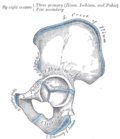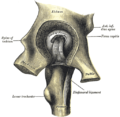Borders
The upper border presents a prominent tubercle, the pubic tubercle (pubic spine), which projects forward; the inferior crus of the subcutaneous inguinal ring (external abdominal ring), and the inguinal ligament (Poupart's ligament) are attached to it.
Passing upward and laterally from the pubic tubercle is a well-defined ridge, forming a part of the pectineal line which marks the brim of the lesser pelvis: to it are attached a portion of the inguinal falx (conjoined tendon of obliquus internus and transversus), the lacunar ligament (Gimbernat's ligament), and the reflected inguinal ligament (triangular fascia).
Medial to the pubic tubercle is the crest, which extends from this process to the medial end of the bone. It affords attachment to the inguinal falx, and to the rectus abdominis and pyramidalis .
The point of junction of the crest with the medial border of the bone is called the angle; to it, as well as to the symphysis, the superior crus of the subcutaneous inguinal ring is attached.
The medial border is articular; it is oval, and is marked by eight or nine transverse ridges, or a series of nipple-like processes arranged in rows, separated by grooves; they serve for the attachment of a thin layer of cartilage, which intervenes between it and the interpubic fibrocartilaginous lamina.
The lateral border presents a sharp margin, the obturator crest, which forms part of the circumference of the obturator foramen and affords attachment to the obturator membrane.












